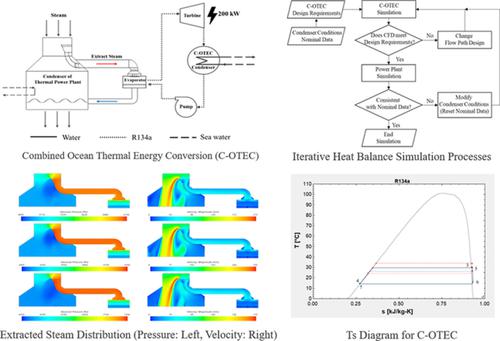当前位置:
X-MOL 学术
›
Int. J. Energy Res.
›
论文详情
Our official English website, www.x-mol.net, welcomes your
feedback! (Note: you will need to create a separate account there.)
Conceptual design for combined ocean thermal energy conversion using computational fluid dynamics and heat balance analysis
International Journal of Energy Research ( IF 4.3 ) Pub Date : 2020-04-22 , DOI: 10.1002/er.5469 Eojin Jeon 1 , Gyunyoung Heo 1 , Iljin Kim 1 , Hyungdae Kim 1 , Hoon Jung 2
International Journal of Energy Research ( IF 4.3 ) Pub Date : 2020-04-22 , DOI: 10.1002/er.5469 Eojin Jeon 1 , Gyunyoung Heo 1 , Iljin Kim 1 , Hyungdae Kim 1 , Hoon Jung 2
Affiliation

|
To overcome the limited efficiency of ocean thermal energy conversion (OTEC), particularly in the mid‐latitudes, combined OTEC (C‐OTEC) could use power extracted from the latent heat of a power plant condenser. Past research in South Korea has demonstrated the feasibility of a 10 kW C‐OTEC system using R134a as a working fluid. As the next phase, a 200 kW C‐OTEC demonstration facility with a thermal efficiency of greater than 3% is proposed. This paper presents the engineering design process for kW‐scale C‐OTEC within a 100 MW‐scale thermal power plant. The design process is divided into two stages. First, to predict patterns in steam flow to a connected external evaporator with a porous medium, computational fluid dynamics are calculated. The results show a conservative margin suitable for the conceptual design. Second, an iterative heat balance simulation method simultaneously evaluates the heat balance analysis of the C‐OTEC design and the thermal impact of the existing power plant. The design stages are then integrated in terms of heat transference capacity.
中文翻译:

利用计算流体动力学和热平衡分析进行联合海洋热能转化的概念设计
为了克服海洋热能转换(OTEC)效率有限的问题,特别是在中纬度地区,联合OTEC(C-OTEC)可以使用从电厂冷凝器潜热中提取的电力。韩国过去的研究表明,使用R134a作为工作流体的10 kW C-OTEC系统的可行性。作为下一阶段,提出了一个200 kW C-OTEC示范设施,其热效率大于3%。本文介绍了100兆瓦级热电厂中千瓦级C-OTEC的工程设计过程。设计过程分为两个阶段。首先,为了预测流向带有多孔介质的连接的外部蒸发器的蒸汽的流型,需要计算流体动力学。结果表明适合概念设计的保守余量。第二,迭代热平衡模拟方法可同时评估C-OTEC设计的热平衡分析和现有电厂的热影响。设计阶段然后根据传热能力进行整合。
更新日期:2020-04-22
中文翻译:

利用计算流体动力学和热平衡分析进行联合海洋热能转化的概念设计
为了克服海洋热能转换(OTEC)效率有限的问题,特别是在中纬度地区,联合OTEC(C-OTEC)可以使用从电厂冷凝器潜热中提取的电力。韩国过去的研究表明,使用R134a作为工作流体的10 kW C-OTEC系统的可行性。作为下一阶段,提出了一个200 kW C-OTEC示范设施,其热效率大于3%。本文介绍了100兆瓦级热电厂中千瓦级C-OTEC的工程设计过程。设计过程分为两个阶段。首先,为了预测流向带有多孔介质的连接的外部蒸发器的蒸汽的流型,需要计算流体动力学。结果表明适合概念设计的保守余量。第二,迭代热平衡模拟方法可同时评估C-OTEC设计的热平衡分析和现有电厂的热影响。设计阶段然后根据传热能力进行整合。











































 京公网安备 11010802027423号
京公网安备 11010802027423号